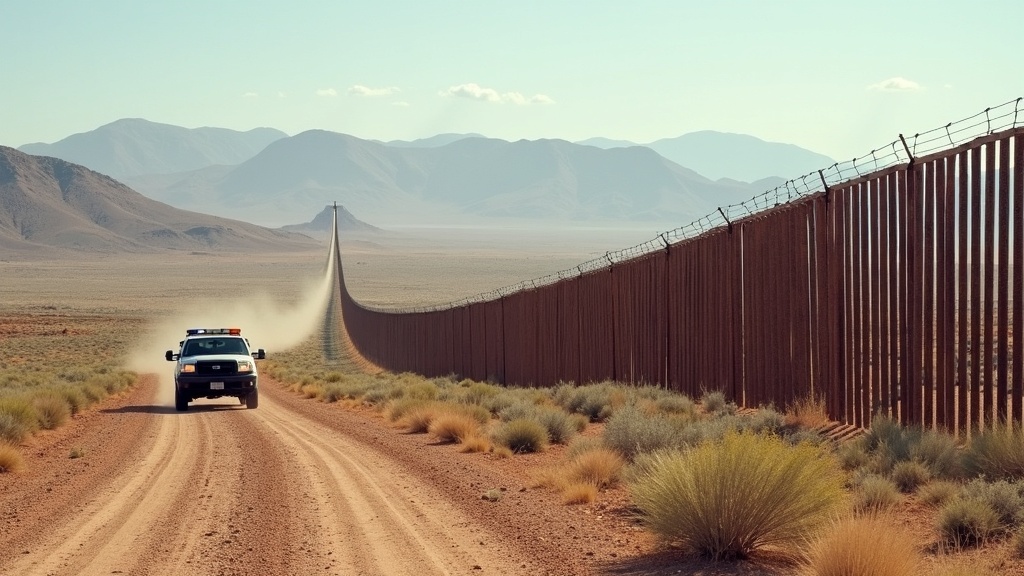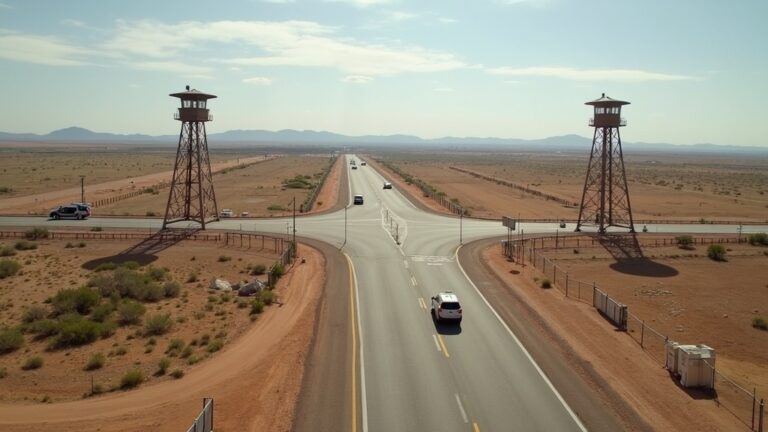Introduction
Border crime isn’t just about things happening along national borders. It ripples into the security and stability of the entire country. When criminal groups target border regions as entry points for illegal smuggling, trafficking, and cyber threats, their actions spill over far beyond the immediate area, reaching deep into society. Understanding the Impact Of Border Crime On National Security is crucial for anyone wanting a super detailed understanding of what truly keeps a nation safe.

Table of Contents
How Border Crime Threatens National Security
There’s more to border crime than most people think. It goes way beyond sneaking contraband over a fence or across a river and covers smuggling, human trafficking, document fraud, organized corruption, arms dealing, and major cross-border violence. These activities fuel even bigger problems: destabilized communities, more funding for organized crime, and sometimes resources for terrorist groups.
Unchecked, border crime wreaks real havoc on national security. It erodes trust in law enforcement, saps public resources, and creates tangled networks where cartels and gangs can, directly or indirectly, play into the hands of foreign adversaries. Sometimes, the difference between criminal cartels and hostile foreign actors blurs, turning these organizations into a larger security dilemma than they first appear.
The Impact Of Border Crime On National Security highlights the interconnectedness of crime and safety. It is essential for policymakers and citizens alike to grasp the implications of border crime on the overall security framework.
Biggest Border Crime Threats Right Now
Drug Trafficking and the Fentanyl Crisis
Drug cartels use the border as the main corridor for moving narcotics into the United States, and, lately, fentanyl has emerged as one of the most eye-catching threats. Potent opioids like fentanyl fuel unprecedented levels of overdoses and addiction. Law enforcement finds itself constantly behind; every checkpoint or seizure just prompts traffickers to invent a new method. This isn’t just a health emergency, but a burden on public safety workers and community resources.
Human Smuggling and Trafficking
Organized networks profit by moving people across borders, whether migrants seeking better opportunities or trafficking victims forced into labor or sex work. Smuggling pipes sometimes end up used by people hiding serious intentions—opening possible routes for terrorists. The adventure is dangerous, leaving many migrants exposed to violence and exploitation, and making this one of the most troubling security and humanitarian challenges at the border.
Firearms Trafficking
The United States doesn’t only face incoming weapons. Stopping southbound guns is just as critical. Many firearms recovered with Mexican cartels and gangs can be traced back to American sources. Those weapons fuel violence in Mexico and the chaos quickly spills back into U.S. communities near the border, making this a tough two-sided threat to safety.
Fuel, Commodity, and Trade-Based Smuggling
It’s much more than drugs and people. Organized groups smuggle fuel, counterfeit goods, and untaxed products across the border to finance other crimes. This undercuts local businesses, reduces tax revenue, and puts honest traders on the losing end.
Money Laundering and Financial Crimes
Many criminal networks rely on border regions to hide dirty money. With cross-border shell companies and complicated trade-based laundering, groups can make billions in illegal profits look legitimate. Sometimes, the money even backs foreign adversaries or terrorist organizations in stealthy ways.
Cyber-Enabled Border Crimes
The internet turns border criminals into global players. Darknet markets, encrypted chats, and cryptocurrency let them work from anywhere, striking at vulnerabilities at the border while keeping a low profile. Direct attacks, like ransomware or data breaches, often target U.S. systems, bringing national security risks way beyond the border zone.
National Security Impacts: Why It All Matters
Border crime affects more than just border towns. Violence linked to cartels and gangs leads to rising murder rates and drags youth into dangerous cycles. Economic security takes a hit too—counterfeit products, theft tied to drugs, and fake trade deals bleed billions from the U.S. and require heavier law enforcement spending.
Homeland security risks are at the top of the list. An open smuggling route doesn’t just mean small-time contraband; it could let dangerous individuals slip through. Bribery and coercion inside border agencies crush public confidence and invite impunity. When criminal groups start acting like underground governments, the law loses sway in entire regions.
Federal Agencies Fighting Border Crime
Several U.S. agencies put in daily work to stop border crime from spreading:
- Customs and Border Protection (CBP): Handles first-line interdiction, inspection, and pushes new technology at ports of entry.
- Homeland Security Investigations (HSI/ICE): Chases international cases, follows money trails, and works to break up transnational crime networks.
- Drug Enforcement Administration (DEA): Targets drug trafficking rings and tries to cut narcotics off at the source.
- Federal Bureau of Investigation (FBI): Tracks connections between organized crime, border violence, and terrorism.
- Bureau of Alcohol, Tobacco, Firearms, and Explosives (ATF): Handles firearms smuggling on both sides of the border.
- U.S. Coast Guard & Department of Defense: Protect maritime borders and give a boost to national defense missions.
More often than not, these teams work together, pulling resources and strategies to address complex cases that bridge both sides of the border. This means communication and quick coordination are must-haves.
Measures to Counter Border Crime
Intelligence and Information Sharing
Stopping cross-border crime requires real-time intelligence. Fusion centers and joint task forces let local, state, and federal agencies pool their insights and detective work. Internationally, the U.S. swaps updates with Mexico and Canada to better track shifting criminal networks.
Technology Integration
The latest technology shifts the odds. Nonintrusive Xray machines let inspectors scan vehicles without causing gridlock. Biometric readers, surveillance drones, and AI-driven tracking systems are being put to work. On the digital side, cyber task forces keep watch on the darknet and monitor cryptocurrency tied to border crime. Together, these tools make it way harder for criminal groups to hide or move undetected.
International and Binational Cooperation
The job needs countries to work together. U.S.-Mexico vetted units, regional security plans in the USMCA, and cross-border anti-smuggling teams set a stronger defense. Globally, outfits like Interpol and the U.N. help plug holes that criminals would otherwise sneak through.
Community and Private Sector Partnerships
Guarding the border isn’t just a government gig. Companies get involved through initiatives like the CustomsTrade Partnership Against Terrorism (CTPAT) to keep supply chains secure. On the ground, community programs steer young people away from gangs, alert authorities to risks, and help restore trust in law enforcement.
Bringing the private sector and the local community into the mix means more eyes, ears, and expertise. This helps agencies keep ahead of new scams and develop solutions that fit the real needs of both businesses and citizens.
Major Challenges in Stopping Border Crime
Countering border crime isn’t simple. Crimes don’t fit neatly in a single box—multiple agencies sometimes step on each other’s toes about who takes the lead. With so much legitimate trade and travel crossing the border, it’s a tall order to scan everything without causing epic traffic jams. Criminal outfits adapt quickly, using anything from underground tunnels to encrypted messaging apps.
Corruption also pops up, undermining efforts and leaving some border regions shaky. Meanwhile, lawmakers and the public often butt heads over how to keep Americans secure without giving up too much privacy and individual freedom.
Emerging Threats to Watch
The border security fight is always a moving target because criminal groups are quick to adapt. Synthetic drugs continue to change, with new compounds skirting laws as fast as they appear. Smugglers are testing weaponized drones, futuristic smuggling vehicles, and elaborate tunnels. Meanwhile, some foreign governments and state-backed groups look for holes to exploit at the border, sometimes teaming up with local criminal or terror networks in ways that are tough for law enforcement to untangle.
Building Stronger National Security Through Border Enforcement
Adjustments to laws and policy updates—such as tweaks to Titles 18, 19, and 21—supply agencies with better legal ammo. Bills for smarter tech, additional staffing, and anti-drone measures keep rolling out in Congress. Public and private teams are locking in tighter controls over container ships, trucking companies, and airplane cargo.
Running down the money trail is another powerful tactic. Following cash and dismantling cartel business models can strike deeper blows than simply busting shipments. Coupled with global diplomacy and steady support for neighbors across the border, these steps help national security keep pace with evolving threats.
Frequently Asked Questions
What makes border crime different from other types of organized crime?
Border crime often exploits gaps between laws, policies, and borders, letting criminals use loopholes to move goods, people, or money in ways that are much harder to track or prosecute compared to regular criminal outfits.
How does border crime affect regular people far from the border?
Drug and human trafficking, cybercrime, and economic crimes can reach any town or city. Even places far from the border get hit with higher crime, increased addiction rates, or economic fallout.
Can technology alone stop cross-border crime?
No. Criminal groups find new workarounds all the time. Technology offers vital tools, but they need to be combined with sharp law enforcement skills and community efforts to really move the needle.
What role do communities play in countering border crime?
Locals are often first to spot suspicious patterns or odd activity before any authority does. Their cooperation, tips, and involvement can be the difference in intercepting serious threats and keeping neighborhoods safer.
Wrapping up, understanding border crime and its link to national security matters more than ever. The threats shift constantly, but with smart policies, teamwork, and new tools, the United States can stay a step ahead—making sure border security means a safer nation for everyone.
If you feel like you need to report a crime involving money laundering, please don’t hesitate to contact your local law enforcement or, if in the United States, reach out to the Homeland Security Investigations or the Federal Bureau of Investigations.
Contact Us:
If you need to contact us for any reason, please feel free to do so here!









